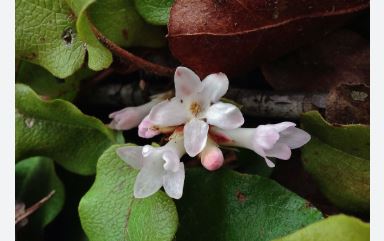
Epigaea repens, commonly known as the Mayflower or Trailing Arbutus, belongs to the Epigaea genus within the Ericaceae family, which is also known as the heath or heather family. This species is characterized by its low-growing, evergreen habit, with small, fragrant, pink or white flowers that bloom in early spring. The genus name “Epigaea” comes from Greek words meaning “upon the earth,” reflecting its ground-hugging growth habit, while “repens” indicates its creeping nature.
The Mayflower is native to eastern North America, with its range extending from Newfoundland in Canada southwards through New England, the Great Lakes region, and along the Appalachian Mountains to Georgia. It grows in various habitats including pine forests, oak woods, and sandy or rocky soils where it forms a part of the understory, often in acidic, well-drained conditions.
Historically, Epigaea repens has a rich cultural heritage. It was named “Mayflower” by early European settlers in America, who saw it as a sign of spring and new beginnings, akin to the arrival of their ship, the Mayflower. This association led to its adoption as the state flower of Massachusetts in 1918. Native American tribes, including the Algonquin and Cherokee, used it for medicinal purposes, treating ailments like kidney disorders and respiratory issues. Its delicate beauty and fragrance have made it a subject of admiration in literature and art, symbolizing the renewal of life in spring. However, due to its slow growth and sensitivity to disturbance, it’s considered endangered or threatened in some parts of its range, with laws in places like Massachusetts protecting it from being picked.
Mayflower is well-adapted to USDA Hardiness Zones 3 through 8. This range reflects its tolerance for both cold winters and moderate to warm summers, provided the soil conditions are right. It thrives in environments that mimic its native habitat, requiring acidic, well-drained soils and partial to full shade, often found under pine or hardwood canopies. The plant’s preference for undisturbed, natural settings makes it more challenging to cultivate outside these conditions, but where it does grow, it’s valued for its early spring blooms, fragrance, and as a symbol of native flora conservation.
Mayflower (Epigaea repens): Characteristics
- Growth Habit: A low-growing, evergreen shrub that creeps along the ground, forming dense mats. It rarely exceeds 6 inches in height, spreading by stolons.
- Flower Appearance: Produces small, fragrant flowers in clusters that are typically pink or white with a five-petaled, somewhat bell-shaped structure. Flowers bloom in early spring, often before or as leaves emerge.
- Leaves: Leaves are alternate, leathery, and evergreen, with an oval shape and a slightly serrated or smooth edge. They are dark green on top and lighter underneath, providing year-round interest.
- Bloom Time: Flowers bloom from late winter to early spring, one of the first signs of spring in its native range, adding a sweet scent to the forest floor.
- Fragrance: Known for its sweet, spicy fragrance which is particularly strong when the flowers are in bloom, making it a delight for anyone walking through its habitat.
- Root System: Has a shallow, fibrous root system that is well-adapted to the often sandy or rocky, acidic soils of its native habitat, but this also makes it sensitive to disturbance.
- Adaptability: Prefers acidic, well-drained soils under the partial shade of trees like pine or oak. It’s not very adaptable to changes in its environment, making it hard to cultivate outside its natural settings.
- Pollinator Attraction: Attracts early pollinators such as bees and flies with its nectar, playing a role in the ecosystem by providing one of the first food sources of the year.
- Conservation Status: Due to habitat loss and its slow growth rate, it’s considered threatened or endangered in parts of its range, with laws protecting it from being disturbed in some areas.
- Ecological Role: Contributes to the understory layer of forest ecosystems, aiding in soil stabilization and providing early spring food for pollinators. Its evergreen leaves also offer ground cover throughout the year.
Mayflower (Epigaea repens): Cultivation
Site Selection
Choose a location with partial to full shade, mimicking its natural woodland habitat. It prefers areas with dappled sunlight or under the canopy of trees like pines or oaks.
Soil Preparation
Requires acidic, well-drained, sandy or loamy soil. Enhance soil with peat or pine needles to maintain acidity and mimic its natural forest floor environment.
Planting
Plant in spring or fall. Since Mayflower is hard to cultivate from seed due to its symbiotic relationship with specific soil fungi, propagation is often done via cuttings or, more commonly, by transplanting wild plants with great care.
Watering
Water sparingly; Mayflower is adapted to somewhat dry conditions once established. Overwatering can lead to root rot. Keep soil moist but not soggy, especially during establishment.
Mulching
Use a light, acidic mulch like pine needles or leaf litter to maintain soil acidity and moisture, and to replicate its forest floor habitat. Keep mulch thin to prevent smothering.
Fertilization
Fertilize very lightly, if at all, as Mayflower grows in naturally poor, acidic soils. If fertilization is necessary, use an acid-loving plant fertilizer in early spring.
Pruning and Maintenance
Pruning is minimal; remove any dead or damaged foliage but avoid disturbing the plant’s delicate root system. It’s a low-maintenance plant once established.
Pest and Disease Management
Generally pest and disease-resistant, but watch for issues like root rot in overly wet conditions. Good drainage and air circulation are key.
Propagation
Propagation by seed is challenging due to the need for specific mycorrhizal fungi. Layering or taking softwood cuttings in summer might work, but success can be variable. Division of established plants is another option, handled with extreme care.
Winter Care
In its natural range, no special winter care is needed as it’s quite hardy, but in colder zones, ensure it’s well-mulched to protect the shallow root system from frost heave.